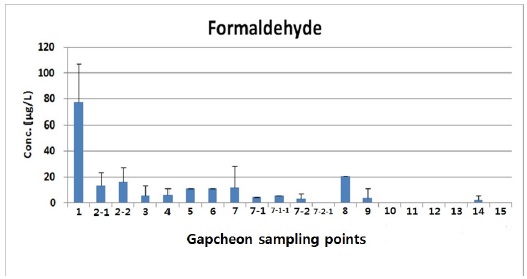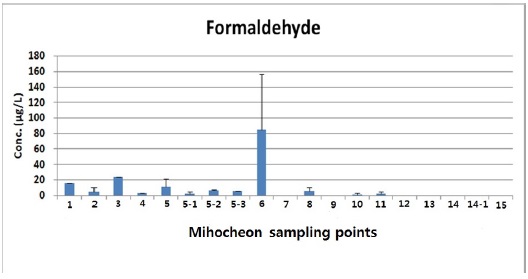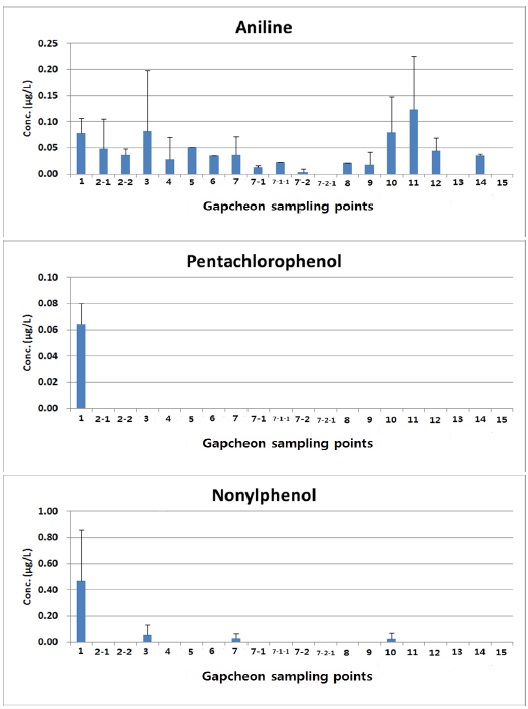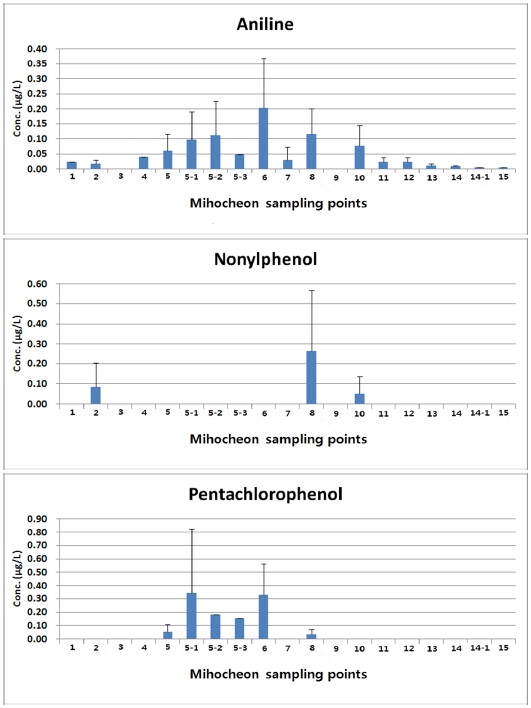



Water quality is of concern to water utility operators, public health officials, and populations using the water. If any contaminant is released from a point of entry, it could be spread rapidly throughout the water stream. So the identification of the location of the points of entry and its release history are critical informations to establish the management strategy.
Aniline, nonylphenol, pentachlorophenol and formaldehyde in 39 surface water samples were analysed using Gas chromatography-mass spectrometry (GC-MS) methods. Formaldehyde, aniline and nonylphenol were mainly detected in the near sites where industrial waste water and domestic sewage were discharged into stream. But pentachlorophenol was detected in the downstream samples where pulp manufacturing plants were operated.
Results indicate that pentachlorophenol found in main stream of Guem river was mainly introduced from pulp manufacture industries. Otherwise, formaldehyde, aniline and nonylphenol were mainly contaminated from the industrial waste water and domestic sewage.
잠재적으로 해로운 영향을 줄 수 있는 다양한 오염물질들은 환경으로 꾸준히 배출되고 있다(Abdel Salam
또한 안정적인 수질관리를 위해서는 하천에 존재하는 유해화학물질의 배출원이 될 수 있는 산업단지, 제조공장에서 사용하고 있는 여러 화학물질에 대한 집중적인 관리·감독과 주기적인 모니터링이 필요하다. 이를 위해서 환경부에서는 ‘수질관리과’를 만들어 수질관리를 총괄업무를 강화하였고, ‘수생태계 복원 및 사고 대응 체계 구축을 통한 공공수역 살리기’, ‘선제적 수질관리를 위한 수질예보제 운영’, ‘수질오염 사고시 신속한 대응을 위한 실시간 예측시스템 개발․운영’, ‘국가 수질 측정망 통합 DB구축․관리, 중장기 수질평가 연구’ 등을 수행하며 국민생활과 수생태계와 연관된 수질환경 문제해결을 위해 지속적인 노력을 해오고 있다.
2000년대 이후부터 전통적인 수질오염물질에 더해 각종 독성물질, 발암성 물질, 내분비계장애물질 등에 대한 우려가 커지고 있으므로 이를 반영한 환경기준 설정이 필요하다. 또한 각 지역에 따라 수계배출원이 다르므로 효과적인 관리를 위해서는 환경기준을 일괄적으로 적용하기 보다는 지역에 따는 특성을 반영할 필요가 있다. 이를 위해 규제 대상물질 선정과 그 물질의 규제치를 정할 때 지역단위 조사 자료를 바탕으로 하는 것이 바람직하다. 실생활에서 유해물질 노출상황을 고려하여 사람의 건강보호와 더불어 수생생물 보호를 위해서는 지역별로 특이적으로 검출되거나, 검출농도 및 빈도가 높은 항목들에 대해서 오염물질 발생 원인을 추적하고 오염 원인을 규명하는 작업이 필요하다.
이를 위해서 본 연구에서는 금강의 대표적 하천인 갑천(20지점)과 미호천(19지점)에서 유해화학물질의 발생원을 추적하고 오염원인을 규명하고자 하였다. 지역에 특화된 대상물질을 골라내기 위하여 최근에 수행되었던 국가 연구과제의 결과를 분석하였으며, 그 결과 우선 조사해야 할 물질로 formaldehyde, aniline, nonylphenol, pentachlorophenol 4가지를 선정하였다. 합성원료인 aniline과 페놀류인 nonylphenol, pentachlorophenol은 LLE-GC-MS(liquid-liquid extraction gas chromatography mass spectrometry) 분석법을 사용하였으며, 알데히드류인 formaldehyde는 HS-GC-MS(headspace gas chromatography mass spectrometry) 분석법을 사용하였다.
내부표준물질(internal standard, IS)을 포함한 각종 표준물질은 Sigma-Aldrich(Merck, St. Louis, Missouri, USA)의 고농도 표준용액을 희석하여 사용하였다. 분석용 methanol과 dichloromethane은 Burdick & Jackson (Honeywell, Morris, New Jersey, USA)의 시약을 사용하였고, 정제수는 초순수 milli-Q(millipore corp., milford, MA, USA)를 사용하였다. 모든 초자 기구는 세제, 증류수, 아세톤, 메탄올로 연속하여 세척한 후 350℃에서 4시간 이상 가열한 후 오염이 없는 곳에서 방냉한 것을 사용하였다.
금강수계 지천인 갑천, 미호천을 대상으로 2014년 5월부터 11월까지 4회에 걸쳐 조사하였다. 채수방법은 갑천과 미호천으로 들어오는 소하천의 하류부터 시작하여 상류까지 단계적으로 올라가는 방법으로 오염원 추적을 위해 진행하였다. 조사지점은 총 39개 지점으로써 갑천이 20개 이었으며, 미호천은 19개 이었다. 각 지점에 대한 명칭 및 자세한 세부내용은 Table 1, 2와 Fig. 1에 제시하였다
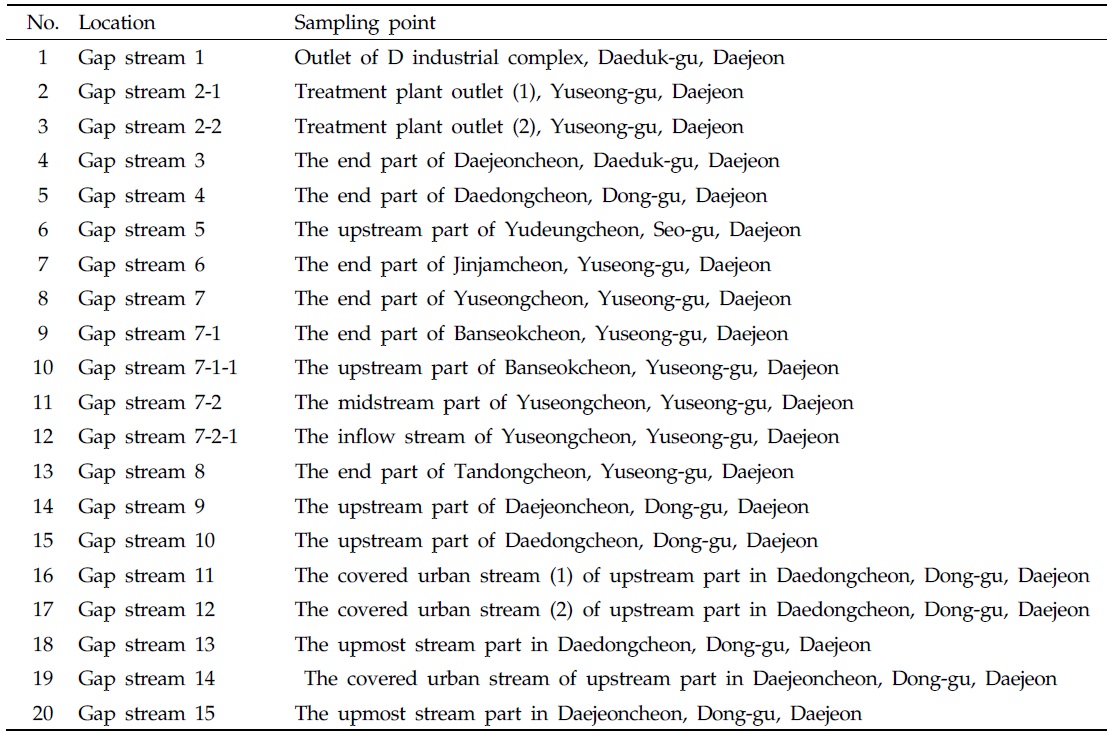
Sampling points on the monitoring of potential hazardous compounds contamination routes in Gapcheon
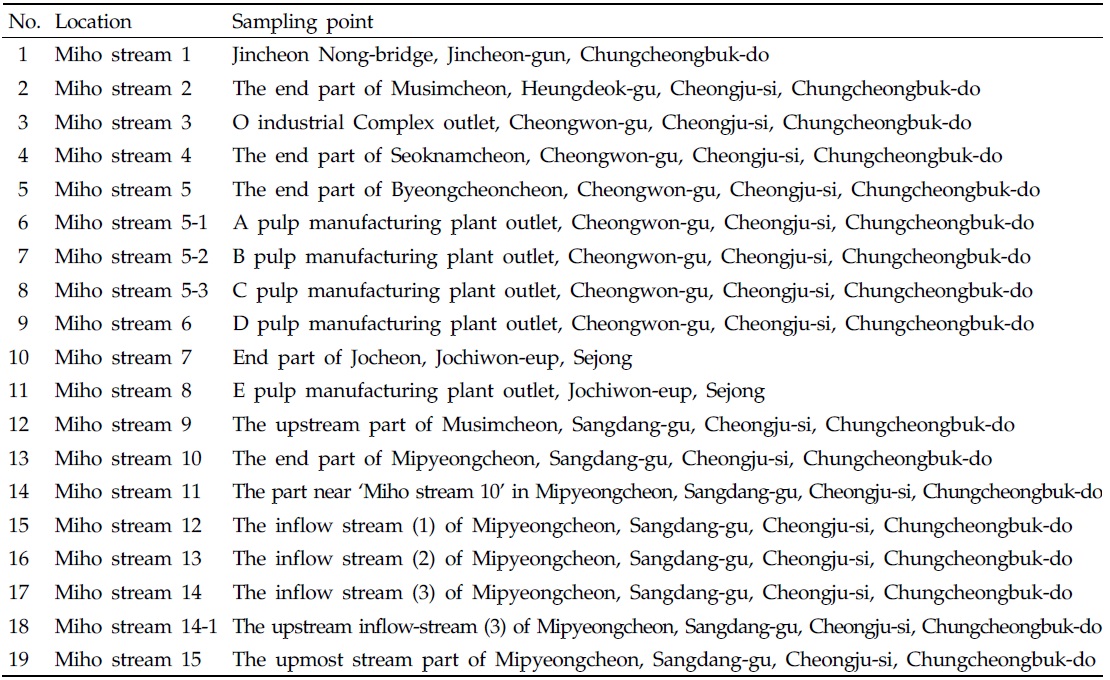
Sampling points on the monitoring of potential hazardous compounds contamination routes in Mihocheon
시료용기는 미리 세척한 후 건조시킨 Environmental Sampling Supply(San Leandro, CA, USA)사 제품의 테플론(teflon) 마개가 있는 시료채취용 갈색유리병을 사용하였다. 이 용기는 유기물이 용출되지 않음을 증명하는 인증서를 포함하고 있다. 유기화합물 분석시료는 각 전처리 방법별로 분리하여 테플론 마개가 있는 1 L 갈색유리병과 40 mL 갈색 바이알에 headspace 없이 채수하였으며, 검출 시 재분석을 위해 각 지점마다 3개씩 6개 시료를 채수하였다. 채수한 시료는 4℃ 온도를 유지하기 위해 현장에서 얼음을 넣은 아이스박스에 보관하였으며, 채수한 시료는 실험실로 이송하여 분석 전까지 냉장 보관하였다.
Formaldehyde는 유도체화 시킨 후 HS-GC-MS 분석법을 사용하였다. 10 mL headspace vial에 시료 3 mL를 취하고 pH 9.0 buffer(sodium bicarbonate : potassium carbonate = 3:1)로 조절 후 내부표준물질(acetone-d6)을 가한 다음 유도체화 시약(trifluoroethylhydrzine)을 첨가하여 GC-MS로 분석하였다.
준휘발성 유기화합물인 aniline, nonylphenol, pentachlorophenol은 LLE-GC-MS 분석법을 사용하였다. 1,000 mL 분액깔때기에 시료 1,000 mL를 넣은 후 내부표준물질로써 phenanthrene-d10를 넣었다. 다음으로 염화나트륨 40 g을 넣고 추출용매인 디클로로메탄 40 mL를 넣은 다음 중성과 염기성에서 각각 추출한 후 추출액을 진공회전증발기로 100 μL까지 농축하였다. 농축한 시료는 필요하면 정제과정을 거친 후 GC-MS로 분석하였다.
선택이온 또는 정량이온에 대한 크로마토그램을 작성하여 각 물질의 머무름 시간에 해당하는 위치 피이크로부터 면적을 측정하고, 미리 작성한 검정곡선으로부터 각각의 양을 구하여 시료 중 농도를 산출하였다.
본 연구의 분석방법에 대한 신뢰성 확인을 위해 검출한계, 정량한계, 검정곡선, 정밀도, 정확도, 회수율에 대한 정도관리를 아래와 같이 수행하였다.
모든 정도관리는 분석성분이 검출되지 않는 하천수를 이용하였으며, 예상 검출한계 농도를 첨가한 7개의 시료를 준비하여 하천시료와 같은 실험절차에 따라 분석하여 얻은 표준편차에 3.14를 곱한 값을 검출한계로 하였으며, 10을 곱한 값을 정량한계로 하였다. 분석 대상 물질의 정량한계는 각각 2.7 μg/L (formaldehyde), 0.005 μg/L (aniline), 0.044 μg/L (nonylphenol), 0.005 μg/L (pentachlorophenol)이었다. 검정곡선 작성 결과 formaldehyde의 직선성(r2)은 0.999 이상의 값을 보였고, aniline, nonylphenol, pentachlorophenol의 직선성(r2)은 0.994 이상의 값을 보였다.
선택한 4가지 유해화학물질들을 적정 농도로 첨가한 5개 시료에 대해 실험절차에 따라 분석하여 정량하였을 때 상대표준편차를 정밀도, 참값에 대한 백분율을 정확도로 반영하였다. 정량 결과, 정밀도는 10.9% 이내 이었으며, 정확도는 83.5-113.6% 범위를 보였다. 또한 aniline, nonylphenol, pentachlorophenol의 회수율은 75.8~109.9% 범위를 보였다. 이 모든 정도관리 결과를 종합하면, 높은 신뢰성을 확보한 것으로 볼 수 있다.
Formaldehyde은 갑천 20개 조사지점의 평균농도가 14.2 μg/L이었으며, 농도분포는 3.5∼115.6 μg/L를 보였다. 미호천 19개 조사지점의 평균농도는 14.7 μg/L이었고, 농도분포는 3.3∼178.6 μg/L이었다. Formaldehyde의 분석 결과를 Table 3, 4와 Fig. 2, 3에 정리하였다.
[Table 3.] Analytical results of formaldehyde in Gapcheon
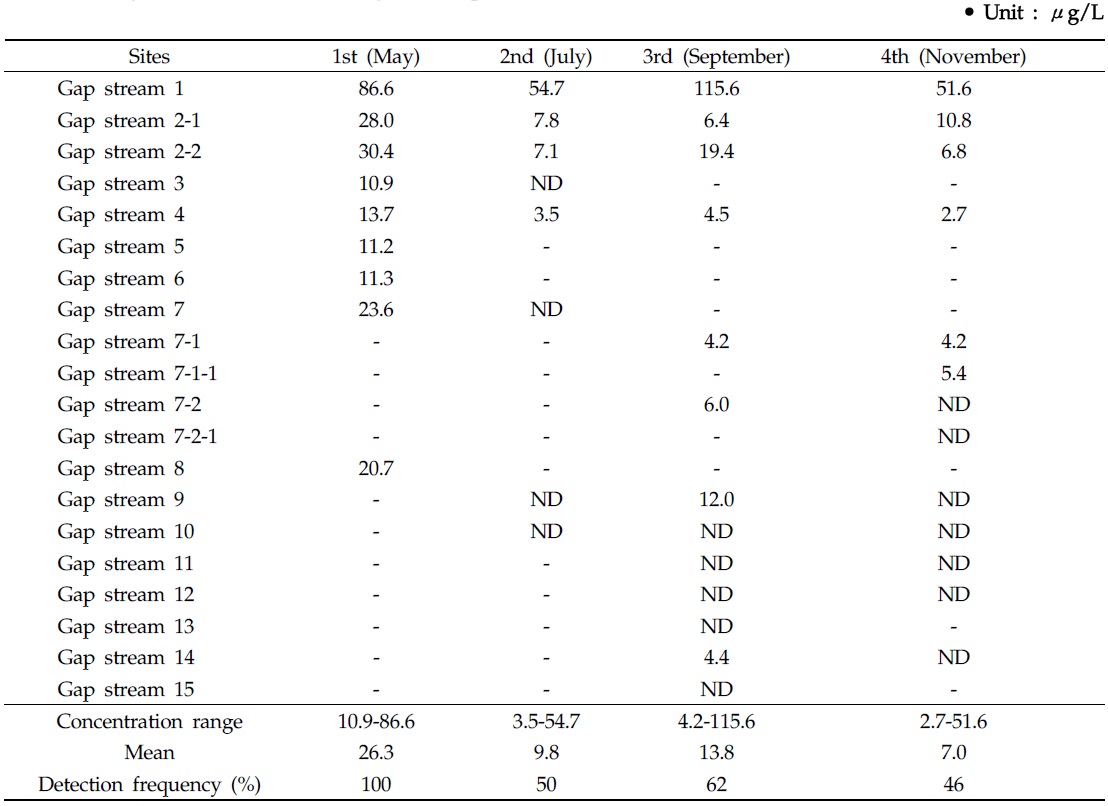
Analytical results of formaldehyde in Gapcheon
[Table 4.] Analytical results of formaldehyde in Mihocheon
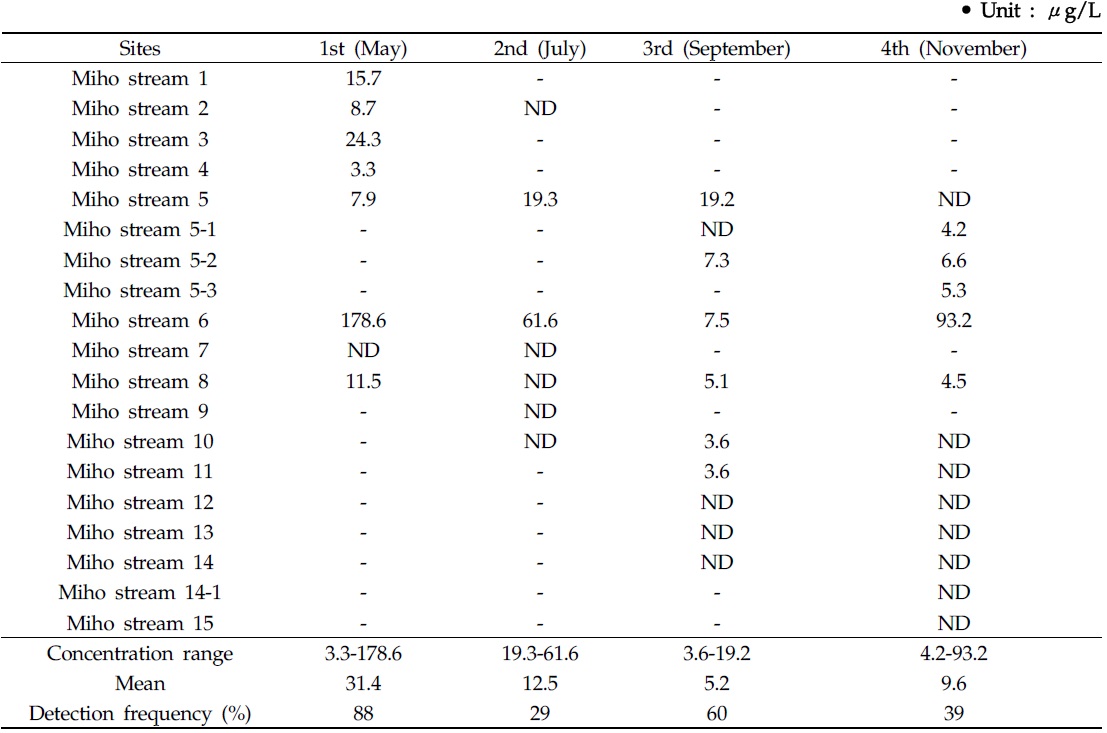
Analytical results of formaldehyde in Mihocheon
Aniline의 경우 갑천 20개 지점의 평균농도와 농도분포는 각각 0.046 μg/L, 0.007∼0.195 μg/L이었고, 미호천 19개 지점의 평균농도와 농도분포는 각각 0.074 μg/L, 0.009∼0.375 μg/L 이었다. Nonylphenol의 경우 갑천 20개 지점에서 평균농도가 0.067 μg/L이고, 농도분포는 0.056∼0.920 μg/L을 보였으며, 미호천 19개 지점은 평균농도가 0.054 μg/L, 농도분포는 0.151∼0.540 μg/L을 보였다. Pentachlorophenol은 갑천 20개 지점에서 평균농도와 농도분포가 각각 0.009 μg/L, 0.044∼0.080 μg/L인 반면 미호천 19개 지점에서는 평균농도가 0.078 μg/L이고 농도분포는 0.016∼0.686 μg/L으로 두 하천의 경향이 달랐다. Aniline, nonylphenol, pentachlorophenol 분석 결과를 Table 5, 6과 Fig. 4, 5에 정리하였고, 오염원 추적 및 오염경로조사 중 미호천 5-1 지점의 3차 조사결과에 대한 chromatogram은 Fig. 6과 같다.
[Table 5.] Analytical results of semi-volatile organic compounds in Gapcheon
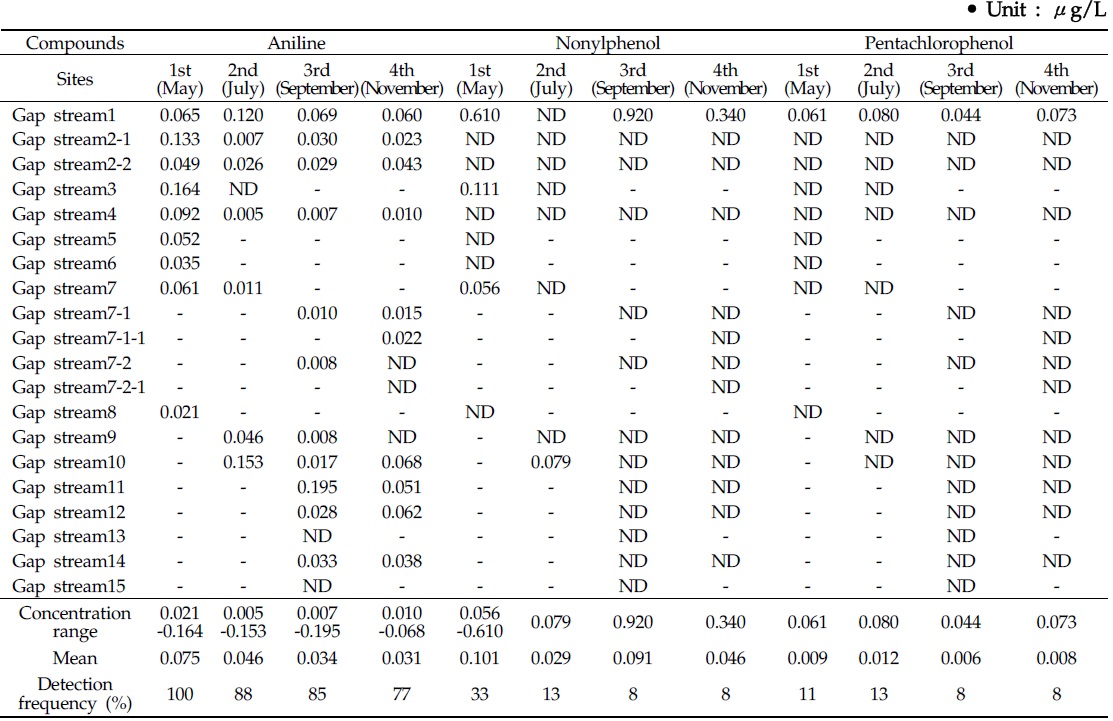
Analytical results of semi-volatile organic compounds in Gapcheon
[Table 6.] Analytical results of semi-volatile organic compounds in Mihocheon
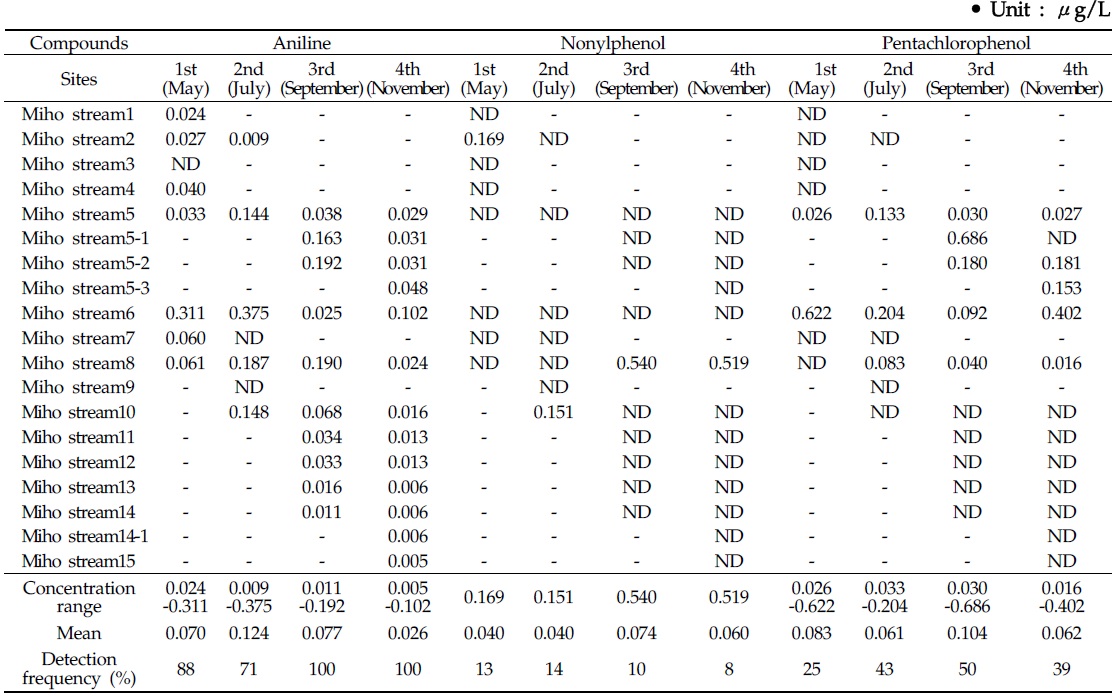
Analytical results of semi-volatile organic compounds in Mihocheon
Formaldehyde의 경우, 공기 중에 포함된 메탄에 햇빛과 산소가 화학반응하거나 탄소 물질이 불완전 연소될 때 자연적으로 생성되기도 하므로 대기환경 중 배경농도 수준이 검출 여부(검출 또는 불검출)를 결정할 것으로 판단하였다. 따라서 그 수준의 값을 일정 수준 넘을 경우 오염원 추적에 활용하였다. Aniline, nonylphenol, pentachlorophenol의 경우, 해당 오염원의 배출시기와 배출량에 의해 영향을 받을수 있는데, 채취장소인 지천은 유량도 적고 변동이 심하므로 배출시기와 양이 물질의 검출 여부 및 검출값을 결정한 것으로 판단된다. 따라서, 오염원 추적 진행시 이 부분들을 고려하여 진행하였다.
본 연구는 금강의 주요 하천인 갑천과 미호천으로 흐르는 지천 하류부터 조사하여 점차 상류 쪽으로 거슬러 올라가 오염물질 발생원에 근접해가는 방법으로 7개월간 경로 추적을 실시하였다. 따라서, 추적이 가능한 오염물질은 단계적으로 최종 오염원까지 근접 후 배출수를 바로 채취하여 분석하였기에 상당 부분 오염경로 추적결과를 구체적이고 명확하게 제시할 수 있다.
Formaldehyde는 화학물질관리법에서 유독물로 지정되어 있으며, 국제암연구소(IARC)에서 2004년에 발암물질 그룹1로 재분류한 물질이다. 또한 백혈병과도 관련성이 높다는 연구결과가 있다(Uchiyama
Aniline은 특히 수용성이 높아 토양에 침투하거나 지하수를 오염시키는 물질이다. 이 물질은 특히 염료, 농약, 의약품 등이 하수 또는 폐수로 직접 배출되거나 분해되었을 때 간접적으로 환경으로 나오게 된다. 또한 화장품, 고무화학물질 및 석탄 변환 폐처리 과정과 같은 에너지 기술에 의한 부산물로 배출될 수 있기 때문에 오염원을 특정사업장으로 추적하기는 매우 어렵다. 시료분석결과 특히 특히 갑천1, 갑천2-1, 갑천3, 갑천10, 갑천11 지점에서 높게 검출되었는데, 이지역의 특성살 주요 오염원은 주변의 공장에서 나오는 폐수와 생활하수가 복합적으로 작용하는 것으로 판단된다.
Nonylphenol은 하천이나 강에서 쉽게 검출되는 물질이다. 독성과 불쾌한 감각수용적 특성 때문에 미국환경보호청(United States Environmental Protection Agency, EPA)에서는 우선순위 오염물질의 목록에 포함시켰으며(Han
Pentachlorophenol 역시 수생태계에 영향을 줄 수 있는 내분비계장애물질로 분류되고 있다(Kawaguchi
금강 본류에 영향을 크게 미치는 주요 하천인 갑천과 미호천에서 formaldehyde, aniline, nonylphenol, pentachlrophenol의 오염원 추적연구를 실시하였다. 하천수 39개 지점의 분석결과, nonylphenol, aniline, formaldehyde는 공장폐수 및 생활하수에서 나오는 것으로 확인되었다. 갑천에서는 금강에 합류하기 바로 전이면서 D산업단지 방류수가 유입되는 갑천 1지역이 다른 시료보다 훨씬 높은 농도로 4가지 물질이 모두 검출되어 갑철의 가장큰 오염물질 배출원은 갑천 1지역으로 판단되었다. 미호천의 경우 특히 pentachlorophenol이 제지관련 회사가 있는 미호천5, 6, 8 지점에서 꾸준히 검출되고 있음을 확인하였다. Pentachlorphenol은 우리나라에서는 이미 제조와 사용이 금지된 물질이므로, 이 지역 사업장의 제조공정이나 폐기물 처리 등의 과정에서 부산물로 발생하는 pentachlorophenol이 유입되고 있는 것으로 추정된다. 갑천과 미호천 모두 주변 사업단지의 영향을 받아 꾸준히 오염물질을 금강으로 보내고 있음을 확인하였으며 앞으로도 인간 건강뿐 아니라 수생태계 보호를 위해 지속적인 위해요소 추적관리가 이루어져야 할 것이다.











